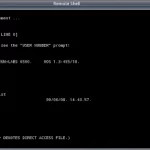Last Updated on: 5th November 2023, 04:17 pm
Web site: cray.com (not active)
Origin: USA
Category: supercomputer
Desktop environment: CLI
Architecture: Cray 1/X-MP/X1/XT3/XT4/XT5/Y-MP/C90/T3D/T3E
Based on: Unix, Linux
Wikipedia: UNICOS
Media: Install
The last version | Released:
UNICOS – a standard operating system for VSMP (Cray Vector Symmetric multi-processor) computers developed by Cray Research. UNICOS is the successor of the Cray Operating System (COS). It was derived from the UNIX System V, and it is the first 64 bit implementation of UNIX and a UNIX similar file system. The UNICOS system is also the first high performance UNIX based operating system which supports SMP.
Computers that proudly carried the Cray name can be divided into groups of related architectural families. The first incarnation was the Cray-1, designed and built by Cray Research founder Seymour Cray. This machine incorporated a number of novel architectural concepts that became the foundation for the line of Vector super computers which made Cray Research (1978..1995) legendary in the scientific and technical computing market.
The Cray-1 evolved through a number of, often one-of-a-kind, sub-variants before being replaced by the evolutionary XMP and substantially different Cray-2. This split between the XMP and Cray-2 marked the first divide in the Cray architectural line that together came to define and dominate the super computing market for the best part of 20 years.
The line of machines designated C1, C2, C3 and C4 were the particular developments of Seymour Cray, who split on friendly financial terms from Cray Research in 1989, to progress the Cray 3 project and found Cray Computer Corporation (1989..1992).
In parallel to this, the main body of Cray Research evolved and developed the original Cray-1 concept through four technological generations that culminated in the 32 CPU T90. Along with this a line of compatible mini super computers, an enterprise class version of a scaled-up SMP Sparc architecture and a line of Massively parallel machines were developed and brought to market.
Cray machines were never cheap to buy or own but provided demanding customers with the most powerful computers of the time. Used by a select group of research labs and the top flight of industry, they defined the very nature of supercomputing in the 1980s and 1990s.
Versions:
– UNICOS: the original Cray Unix, based on System V
– UNICOS MAX: a Mach-based microkernel
– UNICOS/mk: a serverized version of UNICOS using the Chorus microkernel
– UNICOS/mp: not derived from UNICOS, but based on IRIX 6.5
– UNICOS/lc: not derived from UNICOS, but based on SUSE Linux.
– Cray Linux Environment (CLE): from release 2.1 onward
UNICOS/mk is a distributed version of the UNICOS operating system, developed to support future parallel Cray architectures, starting with the Cray T3E. A distinguishing characteristic of UNICOS/mk is its scalability; UNICOS/mk effectively supports large parallel machines, while it provides the image of a single system.



